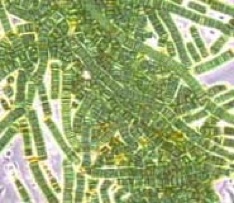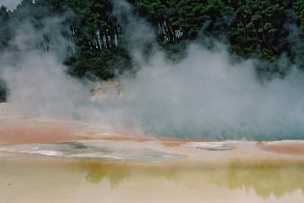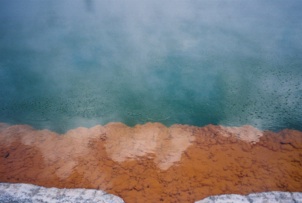building complexity


Did Life's First Cells Evolve in Geothermal Pools?
Earth started as a violent place, its surface churned by continuous volcanic eruptions and cloaked in an atmosphere that would have been poisonous to today's life-forms. Furthermore, the thin primeval atmosphere may have provided only scant protection from the young sun's harsh ultraviolet glare. Given these inhospitable conditions, scientists have long wondered: How did the first cells come to be nearly four billion years ago?
Conventional scientific wisdom holds that life arose in the sea. But a new study suggests that the first cells—or at least the ones that left descendants still extant—got their start in geothermal pools, like those seen at Yellowstone National Park and other geologic hot spots today. The argument rests on one indisputable observation—enzymes common to all archaea and bacteria are built from potassium, phosphorus or zinc, not sodium.
Some biologists suspect that the membranes of early life-forms were not yet the tight coverings that they are today, and would have instead let small molecules and ions flow in and out freely. If life arose in the salty sea, then the first cells and their living relatives might be expected to have enzymes built from abundant sodium—or at least tolerate more sodium internally. That modern archaea and bacteria instead possess internal fluid low in sodium, and enzymes built from other elements hints that they arose in an environment both rich in such elements as well as relatively sodium-free. "If the very first membranes were leaky for small molecules and ions, then the interior of the first cells should have been in equilibrium with their surroundings," explains biophysicist Armen Mulkidjanian of the University of Osnabrück in Germany, lead author of the paper presenting the hypothesis published online February 13 in Proceedings of the National Academy of Sciences. "By reconstructing the inorganic chemistry of the cytoplasm, it might be possible to reconstruct the habitats where the first cells could dwell."
Images of historic persons in movie public domain


Anthrax bacteria: Wikimedia Commons

photosynthetic cyanobacteria:
Wikimedia Commons
nitrogen fixing bacteria on red alder root

multicellular aggregate of bacteria
What is Life, Margulis &Sagan 1995
Lynn Margulis and Dorion Sagan
Much of my understanding about the role of bacteria and the path of evolution derives from this beautiful book. It’s a big “coffee table” book, i.e. 30 cm tall, which means there is room for images and a good layout. However, it is the story told therein that I find entrancing.
I have obtained the timeline information, used in your activity, directly from this book
Margulis, working with her son Dorion Sagan who is a science writer, has, like all of us, her own coherent network of ideas. Thus her concept of autopoiesis, which she does attribute to Maturana, is subtly different from how he intends it.



Earlier start to multicellular life?
Newly uncovered fossils hint that multicellular life may have evolved more than 2 billion years ago -- some 200 million years earlier than previously expected, according to a study published this week in Nature.
The fossils are "not really [what] you expect to find in the rock record 2 billion years before present," said paleontologist Philip Donoghue of the University of Bristol, who was not involved in the research. "These fossils are centimeters in size" and "relatively thick" -- too large to be just a single cell, he said.
The once-biological shapes carved out of black shale formations in Africa outdate the next oldest example of what may have been multicellular life by about 200 million years. Unfortunately, "there's nothing preserved inside," said Donoghue, who wrote an accompanying perspective. "You can't demonstrate [for sure] that it was multicellular [because] you can't see component cells."
The Scientist, Magazine of the Life Sciences
Jef Akst June 2010

the living soil
images of bacteria
I mentioned several kinds of bacteria in the movie from my garden. I found photomicrographs a few of them to give you some sense of what you can imagine at a microscopic level. The middle photo above, however, is visible evidence of bacteria in a symbiotic nitrogen fixing relationship with alder roots; this one from my local forest. Nitrogen fixing bacteria associate with some plants, legumes in particular -- which is why we consider those plants to be “good for the soil” and use them in crop rotations.

a gift from the past
In this youtube I mention a “long string”, namely a timeline string that depicts the sequence of what we know as events and developments from the formation of earth to the present, to scale. Creating such a string is an activity for some of the courses I teach; it is based on a timeline provided in the book “What is Life” by Lynn Margulis and Dorion Sagan (see bottom of page).
You are likely to have seen versions of this timeline with a distorted scale. You are also likely to have heard the point made that our existence on earth is insignificantly short in the context of that duration, or the duration of life on earth. However, I like to make the point that given the continuity of complexification, we are the inheritors of a gift from the past. We have bacteria to thank for all the basic metabolic processes that we now benefit from.